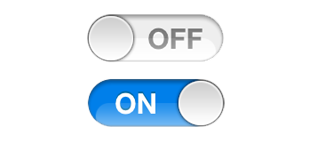UISwitch is mainly used for representing two states. Normal UISwitch has 2 states: ON and OFF respectively.
Creating UISwitch in your cocos2d application is very simple. The steps for creating an UISwitch is described below:
First create an UIView:
UIView *profileView = [[UIView alloc] init];
profileView.frame = CGRectMake(0, 50, 320, 395);
profileView.backgroundColor = [UIColor clearColor];
[[[CCDirector sharedDirector] openGLView] addSubview:profileView];
Then you can create the switch and add to the UIView:
UISwitch *mySwitch = [[UISwitch alloc] initWithFrame:CGRectMake(130, 235, 0, 0)];
[mySwitch addTarget:self action:@selector(changeSwitch:)
forControlEvents:UIControlEventValueChanged];
[profileView addSubview:mySwitch];
When the state of the switch is changed, it will trigger the following function:
-(void)changeSwitch:(UISwitch *)mySwitch{
// By NSLog, you can get the current state of the switch
NSLog(@"%@", mySwitch.on ? @"On" : @"Off");
}
Creating UISwitch in your cocos2d application is very simple. The steps for creating an UISwitch is described below:
First create an UIView:
UIView *profileView = [[UIView alloc] init];
profileView.frame = CGRectMake(0, 50, 320, 395);
profileView.backgroundColor = [UIColor clearColor];
[[[CCDirector sharedDirector] openGLView] addSubview:profileView];
Then you can create the switch and add to the UIView:
UISwitch *mySwitch = [[UISwitch alloc] initWithFrame:CGRectMake(130, 235, 0, 0)];
[mySwitch addTarget:self action:@selector(changeSwitch:)
forControlEvents:UIControlEventValueChanged];
[profileView addSubview:mySwitch];
When the state of the switch is changed, it will trigger the following function:
-(void)changeSwitch:(UISwitch *)mySwitch{
// By NSLog, you can get the current state of the switch
NSLog(@"%@", mySwitch.on ? @"On" : @"Off");
}


No comments:
Post a Comment